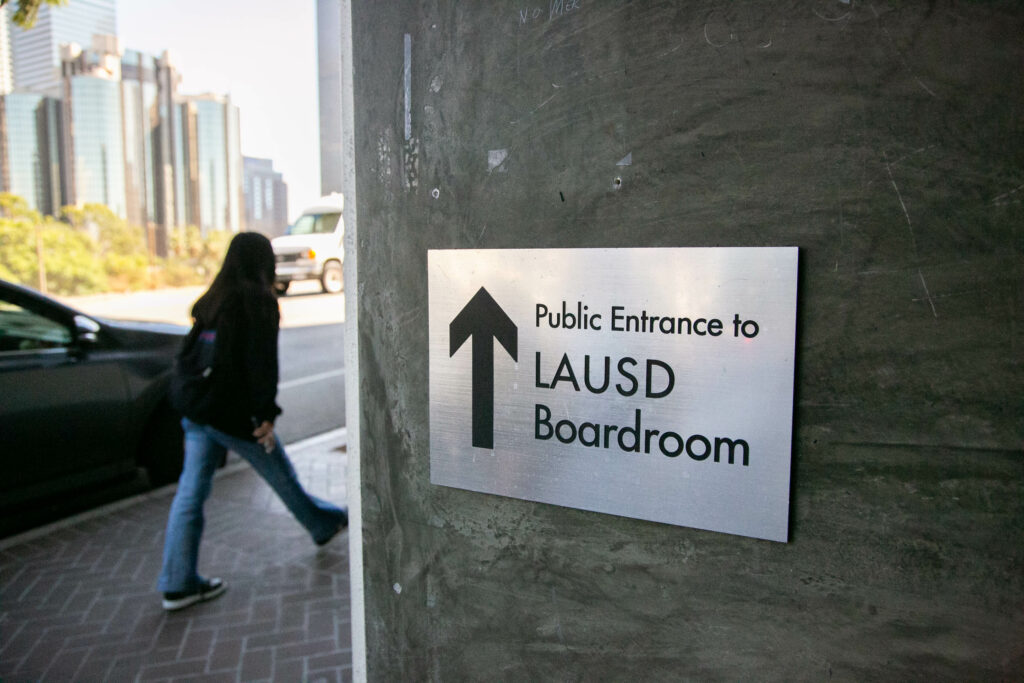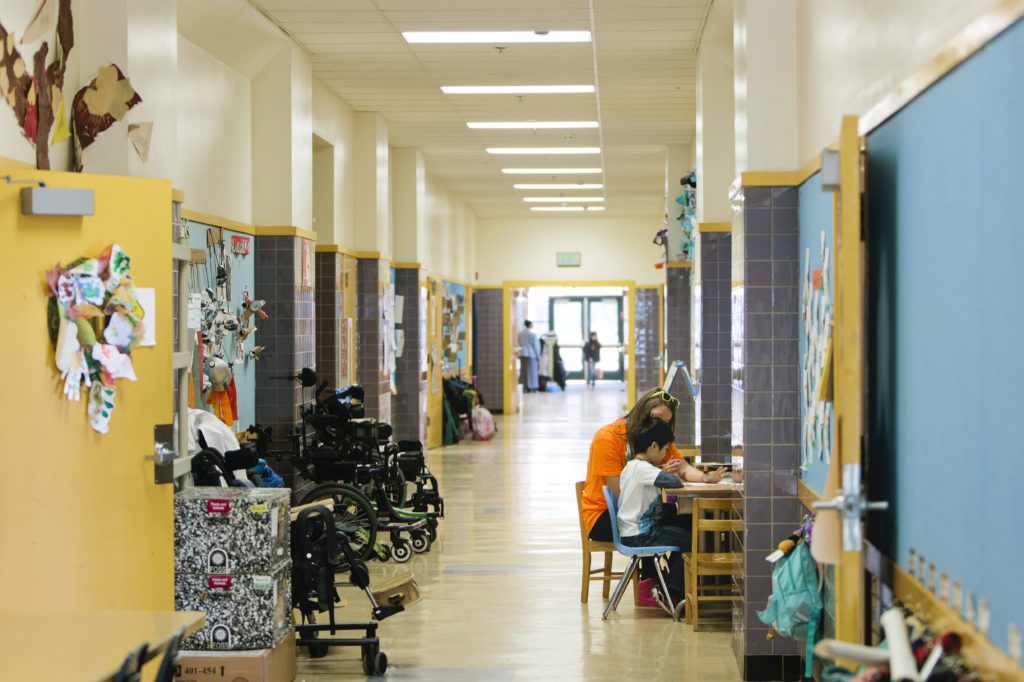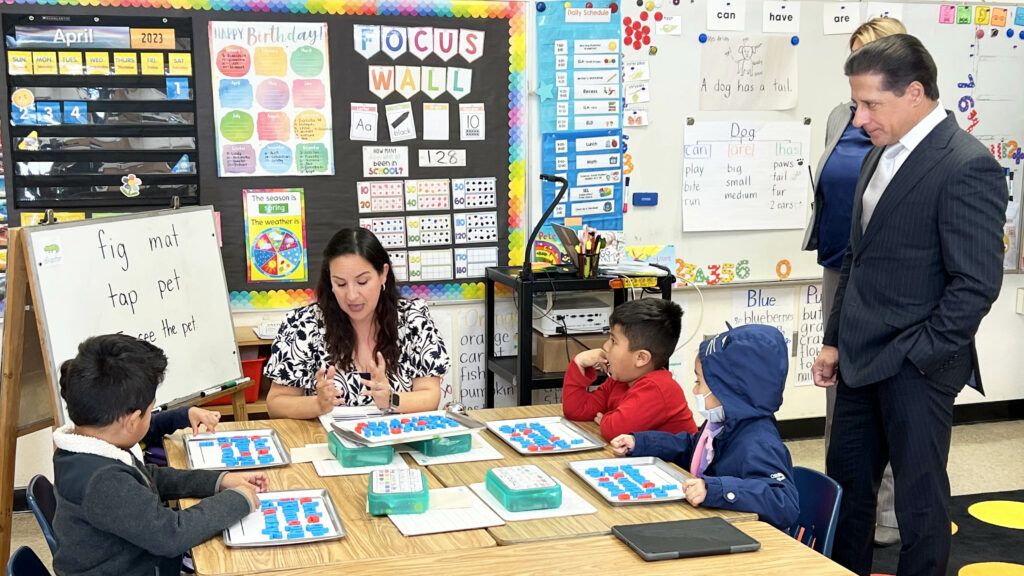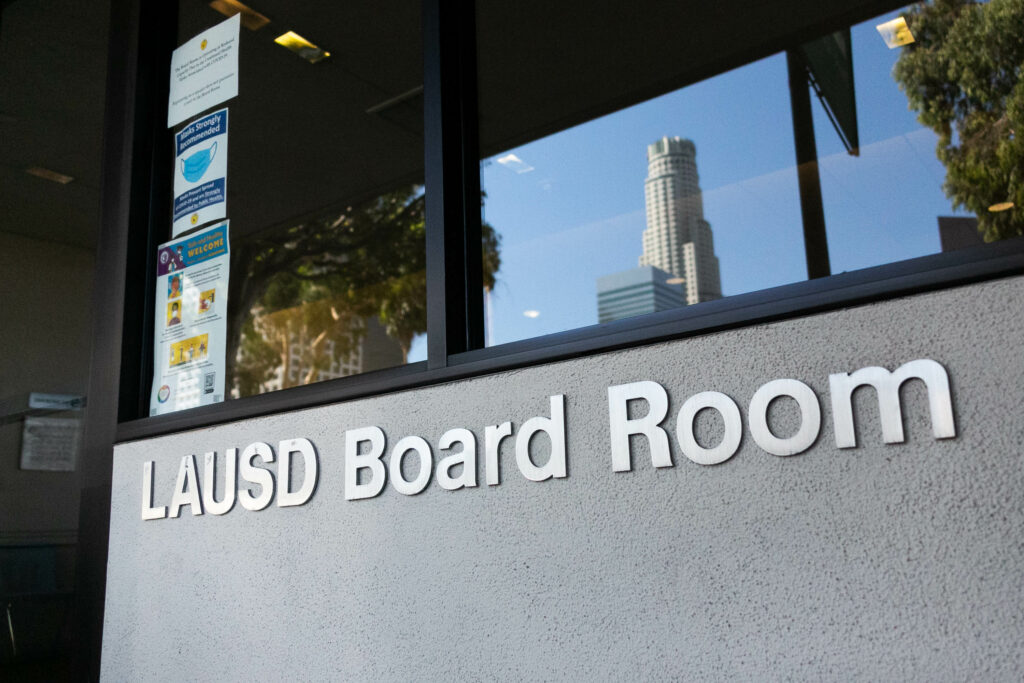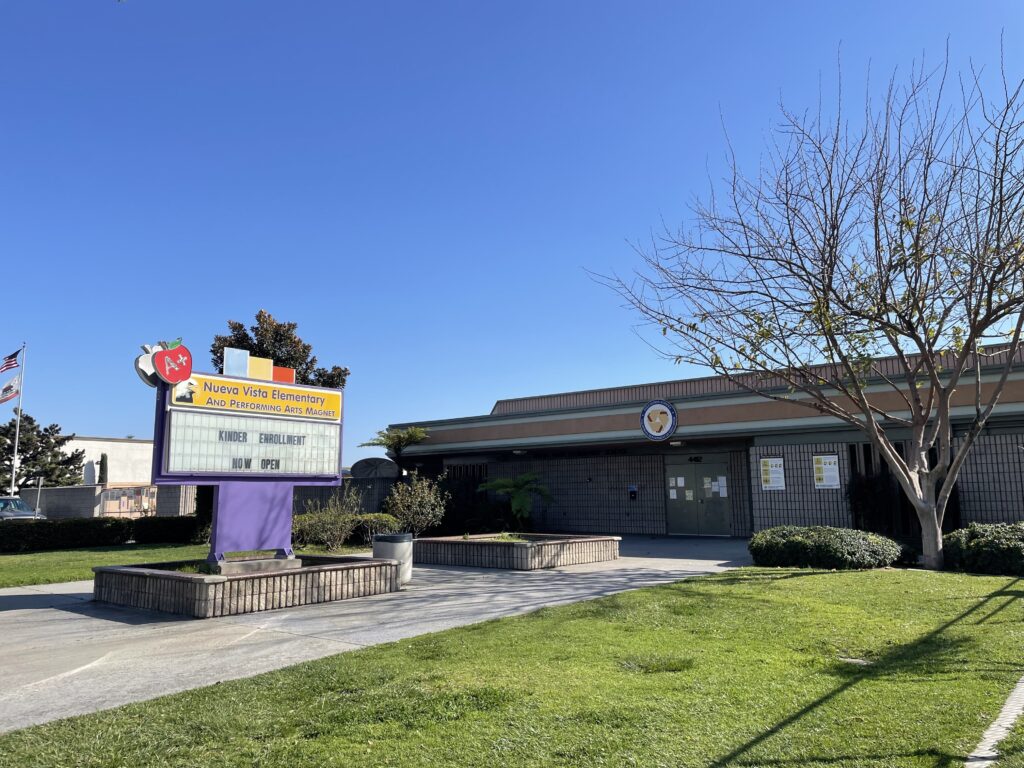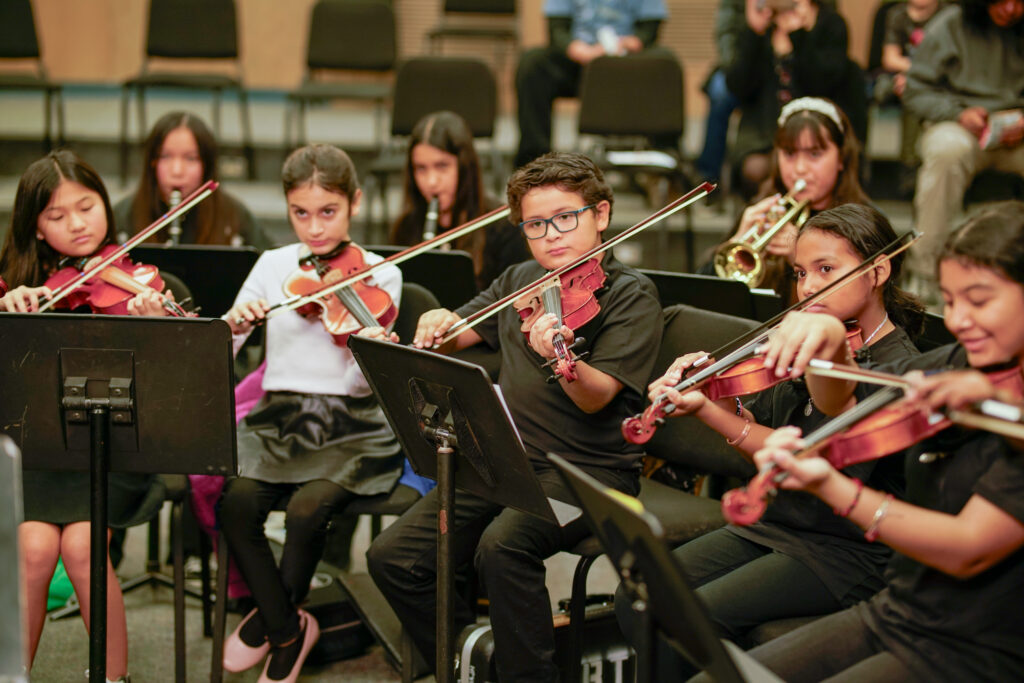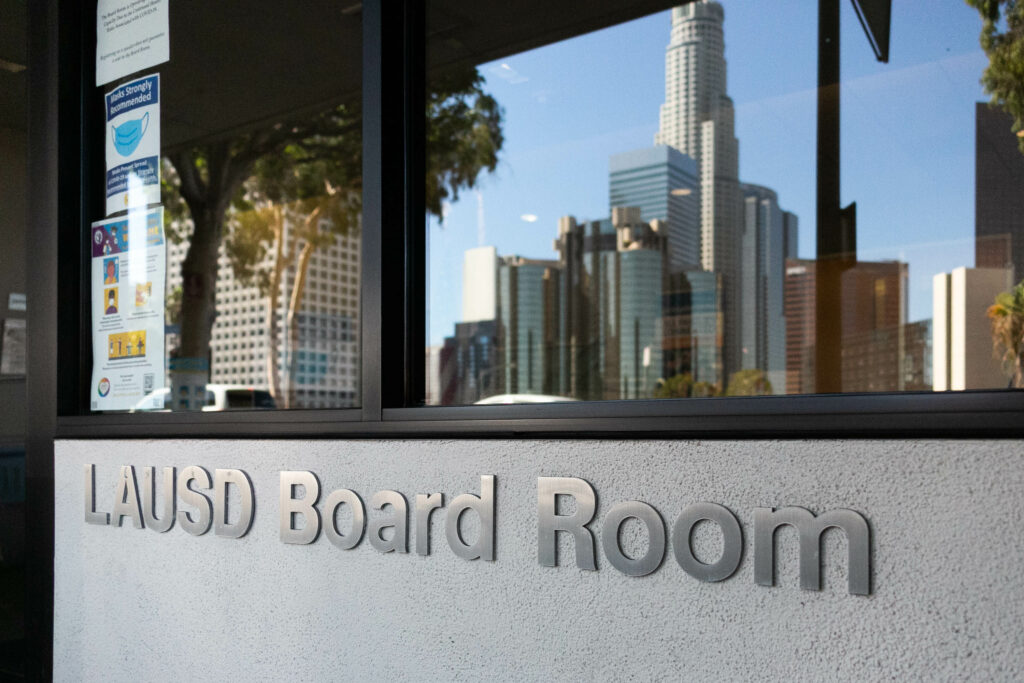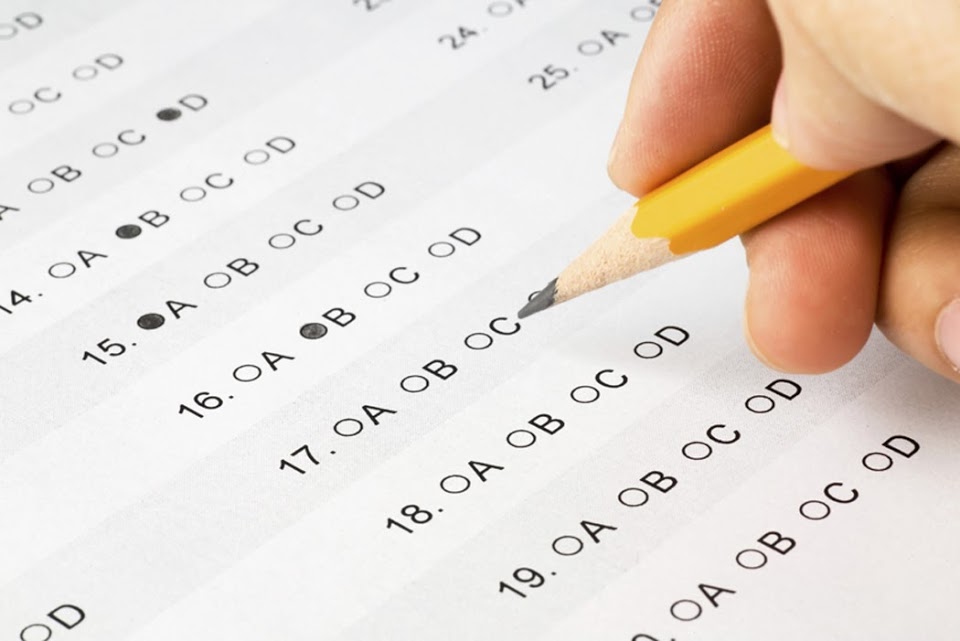
Credit: Julie Leopo/EdSource
Members of the Los Angeles Unified School District school board continued to discuss student safety Tuesday — and are still a ways away from determining whether to revamp its police presence on individual campuses.
A safety task force — which previously recommended each campus choose whether to have police stationed at its site — made a presentation about LAUSD’s approach to student safety, including community-based safety methods such as restorative justice. They will continue to meet in the coming school year.
Discussions about reintroducing police to individual LAUSD campuses are taking place for the first time since George Floyd’s murder amid a 45% increase in incidents between 2017-18 and 2022-23, including suicide risk, fighting/physical aggression, threats, illegal/controlled substances and weapons.
Here’s what the board members said at Tuesday’s meeting. Their remarks have been edited for length and clarity.
School board President Jackie Goldberg: ‘Not really desirous of having armed police on campus’
I spent 17 years teaching in Compton. … We had two sets of gangs. … We then hired school police to come onto campus. The problem was that there were two (officers). The problem was that when the gangs came over the fences, they came over in 10s and 20s. … How did they have guns? They came over in sufficient numbers to disarm the police. So, I’m not really desirous of having armed police on campus. …

What do I think school police can do? I think school police can be in neighborhoods where most of the problems happen. … What we mostly had to do was to have them in the community around the school and for us to be able to find out from trusted — usually — graduates of ours when trouble was about to happen. And so, (police) could be not in twos, but they could be sent in fours and fives to neighborhoods where things were about to come down.
… If you want to stop drug abuse, are you going to have a police officer sitting in the bathrooms because that’s where the exchanges take place? No, we’re not. We’re not going to put a police officer to sit in classrooms. Do we want school police on campus when there’s a fight? Yeah, that may be useful.
… Most of the fights are not bad. And I think as we keep statistics, I would like us to have a notion of what the types of fights were. Was this two or three kids who … called your mother something and they’re fighting and it gets stopped? I think they should be counted, but I think they aren’t the problem. The problem is the massive fights, and those do need to be treated differently.
Secondly, we do not have restorative justice in this district. Period. I visited all 151 of the schools I represent, several of them several times, and in only a handful of them did I see anything that resembled restorative justice.
School board Vice President Scott Schmerelson: ‘I also believe in school police’
Let me just tell you what really bothers me: when people think that school police are supposed to do discipline at school. They’re not supposed to be doing discipline at school. That’s the teacher’s job. That’s my job as the principal, or the assistant principal, or the dean. …

I do believe that we need climate advocates at school. Absolutely — all the help that we can get at making peace at school. Very, very important. … Yes, I do believe in restorative justice. I do. Our kids need to see what they’ve done wrong and how to make amends for what they have done. Very, very important. I also believe in school police.
We are responsible from the minute the kids leave home to the minute they get to school. And, we’re responsible from the minute they leave school to the minute they go home. … That’s why safe passage is really so important too. Kids need to have check-in points along the way home to and from school. Extremely important. Everybody has a job at school, and we should not be pushing people under the bus whether you’re a school police officer, or a climate control officer.
Board Member Rocio Rivas: ‘We do have the data on what we need to do’
We’re not the same since the pandemic. Things have changed. Our students are suffering. They have high anxiety. There’s increase of suicidal ideation.

… We have (positive behavior intervention and support) and restorative justice, but they’re not strengthened. They’re not bolstered. So, the district does have that system in place where we can create safe, loving, culturally responsive schools, but we’re not giving the investments or the support that our schools need.
… The area that needs that support are middle schools. … That is where we start seeing the suicide ideation, when we start seeing the fights, when we start seeing our students needing to medicate themselves.
… We love our kids, and at early ed centers, we love them; we want to protect them. But once they leave those early ed centers, it’s almost as if they lost that system of love and compassion and care. And we put in other systems, and we look at them (as though) all these kids are deviants. No, they are children. They are children until even after they’re 18 … because their brains are still developing.
… We know exactly what we need to do, but we’re not putting the money or the strength or the emphasis. … We’re talking about test scores, but you know what? You are not going to see increases … in student achievement unless that child feels that they’re being heard, that that school cares about them, that they have somebody in there.
… We do have the data on what we need to do. We have the funds. We just don’t have the buy-in from this district, from this building, because it’s so disconnected from our schools and from our communities.
Board Member Tanya Ortiz Franklin: ‘We’ll keep the conversations going’

I’ll just bring our attention back to the Community Based Safety Resolution. The last resolve does ask us … to strengthen community-based safety approaches … and resources as a primary means of cultivating and maintaining positive school climates and keeping school communities safe even in emergency situations.
… We need the (restorative) training throughout for all of the staff members — as many folks can come back before the school year starts. We’ve got $350 million invested in people who are focused exclusively on safety. If we can focus on this community, restorative approach as the primary means — really shifting away from that punitive, traditional, policing model — I think we’ll get even closer to the vision of this resolution that we all passed. I think we’ll keep the conversations going next year in the school safety committee.
Board Member Kelly Gonez: ‘It’s about creating a true infrastructure around community-based safety’
I was looking just at the (Local Control and Accountability Plan) information for our meeting later, and it highlights different demographic groups of students and the percent of students reporting that they feel safe in the school experience survey, and there are significant gaps — like for our Black students, who are rating the lowest in terms of whether or not they feel safe, which obviously is very concerning, as well as the number of students who feel like they are part of their school.

Those numbers, it looks like, took a significant dip in the wake of the pandemic and have not really fully recovered, and I would just surmise that there’s a connection between feeling disconnected or not seen at your school site and whether or not there is true safety and belonging for students.
… It’s not just about restorative justice and the practices, but it’s about creating a true infrastructure around community-based safety. And, I think that’s inclusive of a number of staffing positions as well — beyond, just for example, your restorative justice teachers and beyond the partnerships with community based organizations, which are also integral. It’s about, for example, our classified staffing positions. We know that a number of our incidents happen during lunch, during dismissal.
… I would just ask that in any plan … that we’re providing for the necessary staffing and supervision that our schools and our students really deserve — and especially looking at our secondary schools, because we know that’s where the majority of these incidents are happening.
Board Member Nick Melvoin: ‘The glaring omission (is) … the data on the fights.’

Regardless of our views of what’s happening outside of the school, our responsibility is for school safety on the school campus, and we have different ideas. … But I do think really the glaring omission (is) … the data on the fights.
… I’m trying to understand where we can trace that based on grade levels, and Covid, and the effects of the pandemic and the success or lack thereof of our positive behavioral intervention supports and restorative justice. … (and) on school campuses with the current deployment model, which is not having police there, except for rare emergencies.
… We have different ideas … and I just hope that we can engage, starting from the premise that we all want kids to be safe and talk to each other and not just about or past each other.
And then the last thing, too. … I just want to make sure that the city and the county aren’t off the hook for this — and that as we’re talking amongst each other, we’re also bringing them in.
Board Member George McKenna: ‘We still haven’t come to grips with the reality of what makes the schools safe’
I’ve been in this for 62 years — I’ve never seen police criminalize the children. I’ve seen them respond.
… Do you know that there is no guideline in a teacher’s contract — or even an administrator’s contract — that says you must go break up a fight? The only one that has to do that is someone who’s trained to do that. And that will be a school police officer.

… I have no problem with the climate coaches or whatever they’re called, in addition to the people that have been there in uniform with the licensure and the legal responsibility for student safety … And the only people that have voted for the safety of school police being on campus are people who have been on the campus as administrators, including principals. … The most important people in the school district are the people who run the school, that’s the principal.
… The most police officers we’ve ever had on the campus … is two, and I think it’s understaffed if you only put one on it because they have no backup. They need to be visible in order to assist the students and the prevention of incidents that occur because … the students will confide in them.
….We’re not OK the way we are. And we still haven’t come to grips with the reality of what makes the schools safe and whether or not our school safety officers are a benefit to us. When you start with the premise and use the word the “punitive school police” and that’s the way you introduce it, you are already biased because that means you don’t understand what they do. And you can fill up the room with your accolades and your people that you’ve encouraged to be here, but we have to go to the schools on a regular basis. It makes a school safe.
